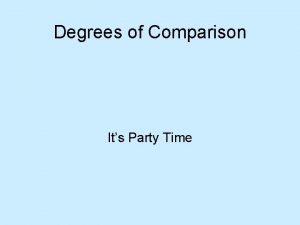Degrees of Comparison Its Party Time Degrees of






- Slides: 6

Degrees of Comparison It’s Party Time

Degrees of Comparison • Often, instead of simply describing something, you may want to compare it with something else. There are three degrees, or forms, of adjectives and adverbs that are used to modify and make comparisons. Most adjectives and adverbs have different forms to show degrees of comparison.

Degrees of Comparison • 1. 2. 3. There are three degrees of comparison Positive Comparative Superlative

Degrees of Modifiers • Things to remember: - For most one- and two-syllable modifiers, add – er to form the comparative degree and –est to form the superlative degree. - In cases when adding –er and –est to one- and two-syllable modifiers would sound awkward, use more and most to form the comparative and superlative degrees. - For adverbs ending in –ly and for all modifiers with three or more syllables, use more and most to form the comparative and superlative degrees.

Degrees of Comparison Adjectives Positive High Comparativ Superlative e Higher Highest Eager More Eager Most Eager Adverbs Positive Comparative Superlative Well Better best Early Earlier Earliest Eagerly More eagerly Most eagerly

Give it a shot! • Identify the degree of each underlined modifier: 1. Thousands of years ago, the only non-forested areas of the Earth were those where the land was the driest. 2. In areas where the environment was more favorable, forests extended from the equator to the far north. 3. Forests expanded by moving into formerly icy regions. 4. However, forests are rapidly declining, as clearing by humans and fire outpace the natural expansion of forest regions. 5. About 30 percent of the world is forested today, the lowest percentage ever.








